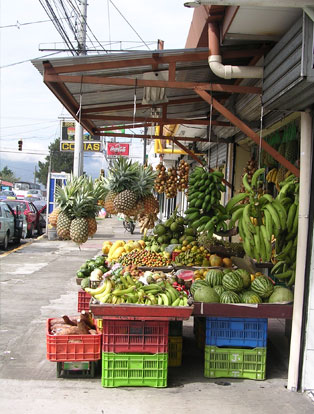(506) 2280-0700
About the Spanish Programs for Spanish immersion:
- How many hours per week is the course?
- What are the levels offered?
- What are the average costs including accommodation?
- What are the teachers qualifications?
- What are the teacher-pupil ratios?
- What is the teaching methodology?
- How long does it take to learn Spanish?
- I’m too old to learn a language, what do you think?
- We Americans are no good at learning languages, are we?
- What is the average age of the students?
- What nationalities are represented in the students?
- Are standard texts used or do you write your own material?
- What is the hourly fee for instructions?
- How would you describe the first day at ILISA?
- What’s the class schedule?
- If I am feeling that I am placed in the wrong group, can I change?
- Do you change teachers during the course?
- Do you have other teaching aids available?
- How many hours per week is the course?
We offer programs of different durations and intensity. Classes run Monday through Friday. The Group-4 program is 4 hours a day. In group Group-4 Plus, 4 hours a day in group is combined with 2 hours private classes in the afternoon. Our One-to-one private classes are 4 or 6 hours daily. The different elements of the above programs can be combined if necessary. - What are the levels offered?
On the first day of your course at ILISA the program director will interview you to determine your language proficiency. Based on this interview you will be placed in a group of your level and language skills. We maintain 6 levels of instruction but also look at age, background and previous language experience when making groups. - What are the average costs including accommodation?
As we have different programs and duration, with or without homestay, prices start at $570 for 2 weeks of group classes without homestay. Including homestay it would be $ 910. Consult our price list for full information. - What are the teachers qualifications?
For ILISA a good teacher is a person that is not only qualified in his/her profession but also has the personality elements to be a good teacher like: patience, imagination, creativity, flexibility and a sincere interest in other people. Such characteristics don’t come with a university degree, but with the person itself and his or her experience. ILISA also continuously provides in-house training and support for its teachers. We have 19 full-time teachers and 8 associated part-time teachers, allowing us to form all the groups we need to meet students’ levels and learning styles. - What are the teacher-pupil ratios?
We never have more than 4 students per group, even during the high season! Our average group size is 2 to 3 students. With this student-teacher ratio, your active participation is guaranteed. - What is the teaching methodology?
ILISA’s communicative approach is based on many years of teaching a combination of applied grammar and practice of the target language. Constant interaction with teachers whose native tongue is Spanish allows you to develop flexibility and fluency in the language without mechanical memorization. Our teachers, and the use of audiovisual aids keep the learning process fresh and exciting, and assure maximum retention of the subjects covered. Because of this communicative approach, our classes have a dynamic impact. You will be able use your new language skills almost immediately, both inside and outside the classroom. - How long does it take to learn Spanish?
This is different for every person. It depends, of course, on your previous knowledge and language learning experience. For instance, if you have studied one or two other languages in addition to your native language, learning another one will be easier. As a guideline we say that somebody with no knowledge at all needs approximately 100 hours to reach a basic conversation level and another 100 hours to obtain a limited working proficiency, provided that he or she lives with a family and puts in the required effort. At ILISA, we don’t promise miracles like instant Spanish through a super crash course. That’s just marketing hype. What we do is provide the ideal circumstances to let you learn. So, how long should you study? As much as your schedule and budget permits; the more the better. It’s a never ending book, well worth reading and very exciting and a passport to a new world. - I’m too old to learn a language, what do you think?
Age can be a factor to but not the most important one. Of course younger people may have an advantage because they’re still students, used to being in a classroom situation and comfortable with it. But you have the experience of age, goal setting, and organization. Whatever your age, it’s important to feel comfortable with what you’re doing and to not be afraid to make mistakes. Never think I’m too old for this. That’s just not the case. - We people from the United States are no good at learning languages, are we?
Nationality itself is NOT a factor in the capacity to learn a language more quickly or not. Americans are not less capable of learning languages than, for instance, Europeans. But since many times they have no foreign language experience, they don’t have the advantage of speaking one or more foreign languages already. Probably the most important factor that will influence the results of your training program is your motivation and dedication. We can give you the best teachers, a well designed program and very small groups, but without your effort and the right attitude the results will be below average. But we expect you come to ILISA with the right attitude to learn, and if you do, you will. - What is the average age of the students?
Most students are between 25 and 45 years old. - What nationalities are represented in the students?
65% of our students come from the United States, the remainder mostly from Europe with the Germans and Swiss making up the majority. However, we regularly receive small groups from Denmark, Holland and other small northern European countries. - Are standard texts used or do you write your own material?
ILISA uses material designed by its teaching staff. This way, we have materials that are fully adapted to the intensive learning situation in Costa Rica. It also allows us to prepare more materials in accordance with different student’s interests. - What is the hourly fee for instructions?
The price for private tutoring is $23 per hour. In the case that a student books classes in addition to their original registration of a four or six hour a day class, the price per hour is $20. - How would you describe the first day at ILISA?
The first Monday in school is a little different to other Mondays. It’s the day when most new students start their classes and we have a lot of new faces. The program director, assisted by one or more teachers, first interview the new students (except absolute beginners) to assess their levels. As soon as they have tested all the students,there will be a short orientation and then the groups will be formed, professors assigned, and classes will start. Remember that the group placement interviews are just an aid to get you in the right group. If during the first few days of classes you or the teacher feel you are in the wrong group, a change is possible. On normal Mondays, students who have already been taking classes can start right away with their new teacher. - What’s the class schedule?
Classes normally are from 8 a.m.- 12.00 noon. There is a coffee break from 10-10.20 a.m. For those who take 6 hours/day programs, classes continue from 1.15 to 3.15 p.m., with a break from 2.10 to 2.20. During peak seasons, some group classes may be moved to 1:15-5:15 p.m. and afternoon sessions to 3:30-5:30 p.m. - If I am feeling that I am placed in the wrong group, can I change?
If you feel you are in the wrong group you will of course discuss this first with the program director who will talk with the teacher. If in their professional opinion you are right, you will change groups. But sometimes you will find out it’s not as bad as it looks. Sometimes students have very specific interest that can’t be dealt with in a group situation: in such cases we suggest they take additional private instruction if possible. - Do you change teachers during the course?
You will have a different teacher every week. This will allow you to experience new voices, accents and personalities. Of course, the basic methodology does not change. Remember that the language learning process is different for everybody: you all have your own learning style, just like teachers have their individual teaching styles. Consequently, what may be a good teacher for one student may not be the best for you. By changing teachers weekly we minimize the risk of a student being ‘stuck’ with a teacher that doesn’t fit his learning style. However, in case of private classes, when student and teacher get along very well, students may opt to extend their classes for another week. This can be coordinated with the program director normally very easily. - Do you have other teaching aids available?
We have 13 computers available to students with software that helps you practice your Spanish, build vocabulary and practice reading and comprehension. All three are fast CD-ROM (4x) equipped 486/66 MHz multimedia computers. We offer a variety of interactive CD-ROM based software as well as hard disk based software. A CD-ROM based multimedia encyclopedia in Spanish is also available. ILISA has incorporated computer-based training through a unique partnership with ‘Transparent Language Inc.’, a major US educational software maker. Transparent Language’s advanced multimedia software will complement your regular classroom instruction with 2 hours per week of computer-based practice tailored to your individual needs. Together with our language lab teacher, you select a theme to work on and start polishing your skills. You can review grammar topics, explore new vocabulary, work on reading comprehension, or practice pronunciation. Regardless of the activity you select, you can move at your own pace.




